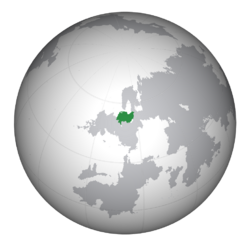Vierzland
Vierz Federation Vierze Föderation | |
|---|---|
| Motto: "Gott und volk" "God and people" | |
| Anthem: O Vierzland hoch in Ehren O highly esteemed Vierzland | |
 Location of Vierzland | |
| Capital and largest city | Adtrüs |
| Official languages | Vierz |
| Ethnic groups | 92.8% Vierz 3.7% Nahorientalisch 1.2% Mischlinge 0.8% Luepolans 1.5% other |
| Demonym(s) | Vierz |
| Government | Federal parliamentary republic |
| Kaspar Vahl | |
| Paul Bachmeier | |
| Eva Weiskopf | |
| Thorsten Hopfer | |
| Legislature | Federal Assembly |
| Population | |
• 2019 estimate | 95,613,152 |
• 2015 census | 94,295,581 |
| GDP (PPP) | 2015 estimate |
• Total | $4.512 trillion |
• Per capita | $47,859 |
| GDP (nominal) | 2015 estimate |
• Total | $4.022 trillion |
• Per capita | $42,663 |
| Gini (2018) | medium |
| HDI (2018) | very high |
| Currency | Vierzmark (VZM) |
| Driving side | right |
| Internet TLD | .vz |
Vierzland, officially the Vierz Federation (Vierz: Vierze Föderation), is a sovereign state in central Patyria. It is bordered by Vostrum to the northeast, Luepola to the east, Lairea to the south, and Apelia to the west. Vierzland is comprised of fourteen states, and the capital and largest city is Adtrüs with a population of 8,103,837, one of the most populous cities on the continent. With the total population around 95 million, the country is the third largest in Patyria in that regard, and is one of the largest in terms of area.
Settlement by Vierzic tribes around the Bertenau Delta in antiquity gradually led to the establishment and expansion of numerous Vierz kingdoms in central Patyria. These states eventually united to form the Kingdom of the Vierz in 1610 AD as a result of the Eastern Patyrian War. The Vierz Kingdom, situated in western Vierzland, united with its eastern and southern counterparts in the aftermath of the First Apelic War in 1766, with Constantine the Great the first Kaiser of the united Vierz Empire. Over the next 150 years, Vierz colonial holdings in West Oridia, Tusola, and South Artalia expanded considerably, especially in the aftermath of Vierz victories in the Vierz-Borish Wars and the Oridian War in the early-mid 19th century.
Colonial conflicts with other Patyrian states, its defeat in the Volgarian Revolutionary War, and the worldwide economic crisis in the late 1920s led to the creation of a military dictatorship in 1929 under Hermann Eschau. Increasing disputes led Vierzland to invade Luepola in 1942, sparking the Great War, which swiftly became a worldwide conflict - the deadliest in world history. Vierzland allied itself with Norverdia, Legatia, and others to defeat Coalcom, an alliance of socialist and communist states in Patyria. Despite the victory of its alliance, relations with Legatia went sour over Vierzland's continued occupation of East Gallia, Luepola, and southern Patyrian states. Disagreements quickly morphed into a lengthy period of geopolitical tension between the two nuclear-armed superpowers - termed the Silent War.
Economic difficulties onset by falling oil prices and worsening conflicts in West Oridia hindered Vierzland's ability to project power. Relations with Legatia, after a brief period of Détente in the 1960s, went sour over the 1974 Straits of Vell crisis and the Luepolan Uprising and ensuing war. Political instability increased after Vierzland's defeat in Luepola, and republican sentiment advanced under Heinrich Werner led to Kaiser Viktor IV's abdication in 1989. This was followed by the official dissolution of the empire in 1990, and the ratification of the new constitution, which created the Vierz Federation, in 1992. The country was reestablished as a federal parliamentary republic, and relinquished all of its overseas holdings in 1993.
Vierzland is constitutionally considered a nation-state for the Vierz people, who constitute 92.8% of the population, the remainder consisting of minority groups such as Caraqis, Mischlinge, and Luepolans that immigrated from former Vierz colonies or neighbouring states. Three-fourths of the country is Catholic, with significant populations of Tariqas and irreligious people. Vierzland is a member of the Council of Patyrian States and the Group of Ten, and is the founder of the Vierz Community and the Vierzic Sprachraum. A great power, The country enjoys a high standard of living, ranking highly in areas of productivity, education, and healthcare, while being one of the world's largest economies. Vierzland has a significant number of tourist sites and world-renowned universities. It is one of the only countries in the world in possession of nuclear weapons.
Etymology
History
Antiquity
Middle Ages
Kingdom to Empire
Great War
Cold War
Luepolan War
Imperial collapse and modern day
Geography
Political geography
Climate
Urbanization
Largest cities and towns in Vierzland
Federal Statistical Office | |||||||||
|---|---|---|---|---|---|---|---|---|---|
| Rank | States of Vierzland | Pop. | |||||||
 Adtrüs  Bertenau |
1 | Adtrüs | Adtrüs Capital Region | 8,103,837 | Friedrichstadt  Kasenberg | ||||
| 2 | Bertenau | Hauvel | 2,992,458 | ||||||
| 3 | Friedrichstadt | Hauvel | 2,644,591 | ||||||
| 4 | Kasenberg | Lonzig | 1,994,342 | ||||||
| 5 | Tilleda | Vogach | 1,523,293 | ||||||
| 6 | Strauben | Geismar | 1,246,785 | ||||||
| 7 | Talheim | Kastor | 1,187,474 | ||||||
| 8 | Schattendorf | Annahof | 1,108,245 | ||||||
| 9 | Gidenburg | Rastede | 1,051,959 | ||||||
| 10 | Jesselitz | Jeien | 998,043 | ||||||

